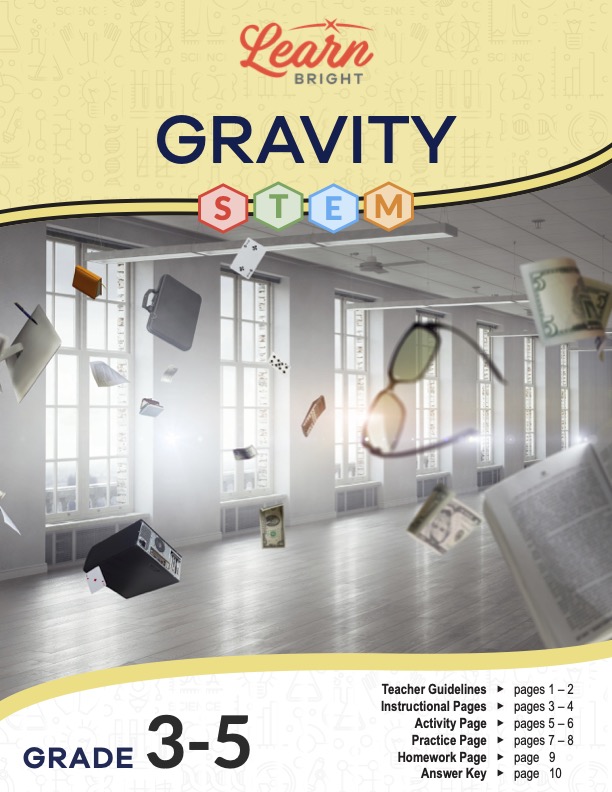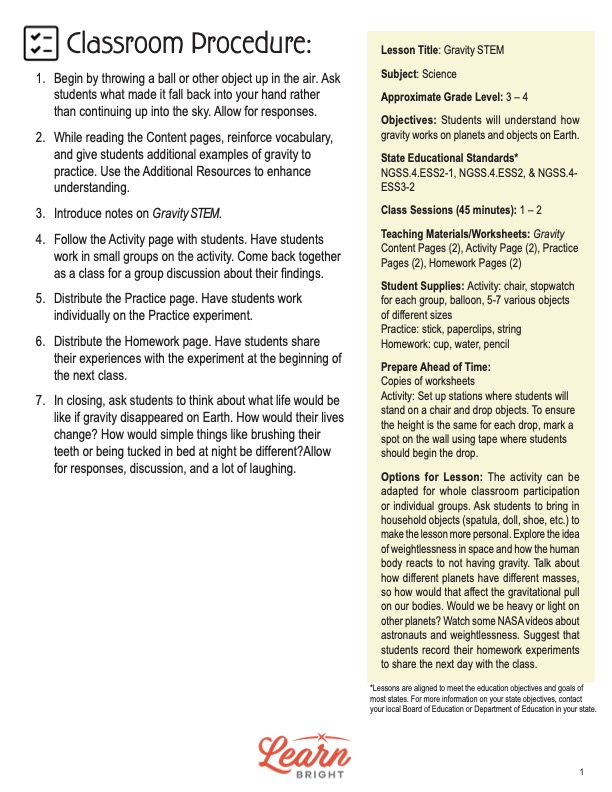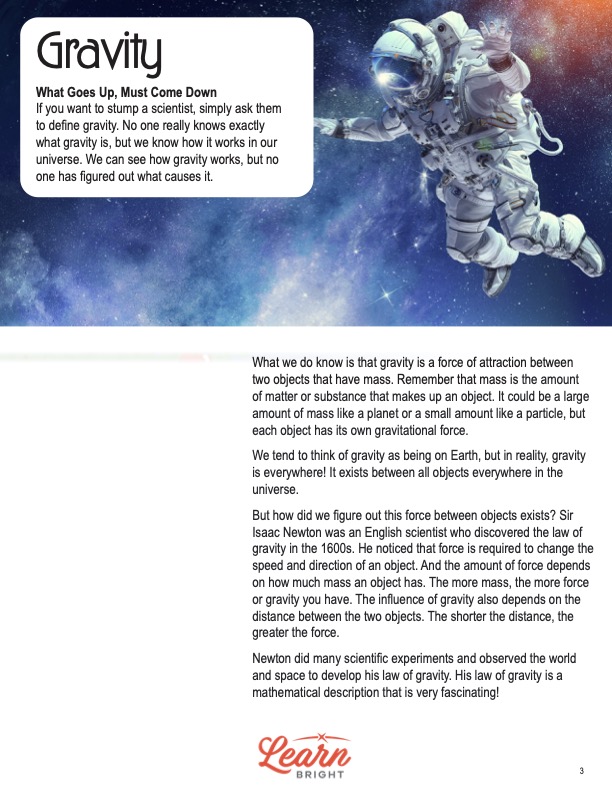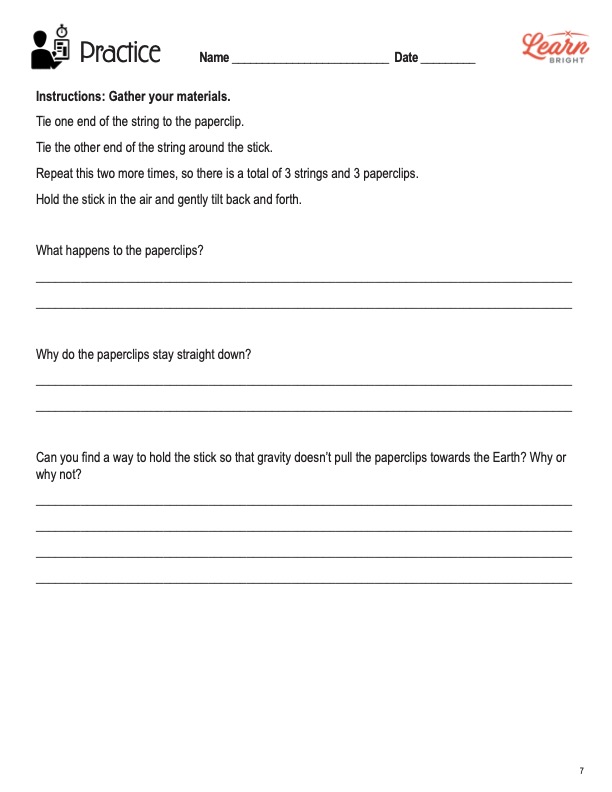Description
What our Gravity STEM lesson plan includes
Lesson Objectives and Overview: Gravity STEM teaches students how to define and explain the concept of gravity. Students will discover how the Earth’s gravitational force attracts objects toward its center. They will learn that this is how planets remain in orbit around the sun. This lesson is for students in 4th grade and 5th grade.
Classroom Procedure
Every lesson plan provides you with a classroom procedure page that outlines a step-by-step guide to follow. You do not have to follow the guide exactly. The guide helps you organize the lesson and details when to hand out worksheets. It also lists information in the yellow box that you might find useful. You will find the lesson objectives, state standards, and number of class sessions the lesson should take to complete in this area. In addition, it describes the supplies you will need as well as what and how you need to prepare beforehand.
The supplies you need for the activity are chairs, stopwatches, balloons, and five to seven objects of various sizes. In addition, the practice and homework assignments require sticks, paperclips, string, cups, water, and pencils. Before you present the lesson, set up the stations where students will stand on a chair and drop objects. To ensure the height is the same for each drop, mark a spot on the wall using tape where students should begin the drop.
Options for Lesson
There are many suggestions in the “Options for Lesson” section for additional activities and exercises or alternate ways to approach certain parts of the lesson. One optional adjustment to the activity is to have the class participate as a whole rather than in groups. You could also ask students to bring their own household objects to make the lesson more personal. Another option is to research the concept of weightlessness in space and talk about how human bodies react to having no gravity. You could discuss how different planets have different masses and how their gravitational pull affects our bodies. Watch a few NASA videos about astronauts and weightlessness. One more idea is to have students record the experiments they will do for the homework assignment and share them with the class the following day.
Teacher Notes
The teacher notes page provides an extra paragraph of information or guidance regarding the subject matter of the lesson. It mentions how students will gain a new understanding of how gravity affects their lives and what the world would be like without it. You can use the lines on this page to write any thoughts you have as you prepare.
GRAVITY STEM LESSON PLAN CONTENT PAGES
Gravitational Force
The Gravity STEM lesson plan contains four content pages. Students will first learn that nobody knows exactly what gravity is or what causes it. We just know how it works in our universe. Gravity is a force of attraction between two objects that have mass. Mass is the amount of matter or substance that makes up an object.
Some objects have a lot of mass, like planets. Others have a very small amount of mass, like a single particle. Regardless of its mass, every single object in the universe has a gravitational force. Typically, when we think about gravity, we think about it as the force that keeps our feet on the ground on Earth. But really, it is everywhere throughout the entire universe.
Sir Isaac Newton, an English scientist in the 1600s, discovered this force. He noticed that force was required to change the speed and direction of an object. The amount of force depends on how much mass the object has. If an object is very massive, then it requires a lot of force. The influence of gravity also depends on the distance between objects. The shorter the distance, the greater the force between the objects. Newton conducted many scientific experiments and observed the world and space to develop his law of gravity.
How Gravity Affects Us
The lesson reminds students that gravity is an invisible force that pulls objects toward one another. The pull of gravity comes from the mass of the object. Students will discover that the reason we “stick” to the Earth is that the planet has such a great amount of mass. Its mass pulls against the mass of our body. Even though the human body has a gravitational pull as well, it is much less strong compared to that of the Earth.
Our weight is actually how gravity is measured. When we step on a scale, we are measuring gravity’s pull on our body. Even though objects have different masses and weights, gravity affects them the same way. If you drop a brick and an apple from the same height atop a building, they will hit the ground at the same time. Earth’s gravitational pull rate is exactly the same for any object, regardless of its weight.
In the same way that Earth’s gravity keeps us grounded (literally), the planets remain in orbit around the sun. The orbital patterns of each planet depend on the gravitational force between it and the sun. And this applies to the forces among the various planets and other celestial bodies around them. (This is why the moon orbits the Earth.)
Albert Einstein and Light
Gravity doesn’t just affect objects with mass; it also affects light. Albert Einstein discovered that light turns redder as gravity pulls on it. Our human eyes can’t see the change, but scientists use special instruments to measure the color of light.
Black holes in outer space have more mass than any other object we know of. They have such a strong gravitational pull that even light gets sucked in and stuck. Living on Earth would be impossible without gravity. It holds our atmosphere together and allows us to breathe as a result.
GRAVITY STEM LESSON PLAN WORKSHEETS
The Gravity STEM lesson plan includes three worksheets: an activity worksheet, a practice worksheet, and a homework assignment. Each one will help solidify students’ grasp of the lesson material and help them demonstrate their knowledge. The guidelines on the classroom procedure page outline when to hand out each worksheet to the class.
OBJECT DROP EXPERIMENT ACTIVITY WORKSHEET
Depending on what you prefer, students can work in groups for the activity or you can make it a class experiment. Students will gather the various items you provide and decide who in their group will perform each role. Each group will have a Dropper, Recorder, and Timer. The Dropper will stand on top of a chair and hold each object at the starting point. When the Timer starts the stopwatch, the Dropper will let go of the object. As soon as the object hits the ground, the Timer will stop the watch. The Recorder will then write the time in the chart on the worksheet page. They will do this for each object. After completing the experiment, students will answer two questions at the bottom of the worksheet.
PAPERCLIP EXPERIMENT PRACTICE WORKSHEET
The practice worksheet requires students to conduct an experiment using paperclips, string, and sticks. First they will tie one end of the string to the paperclip and the other end around the stick. They will do this three times so they have three sets of paperclips, string, and sticks. They will hold the stick in the air and gently tilt it back and forth. The worksheet lists three questions for students to answer regarding what they observed during the experiment.
GRAVITY STEM HOMEWORK ASSIGNMENT
For the homework assignment, students will gather the supplies they need and ask their parents to find a place to conduct the experiment. Using the pencil, they will poke a hole in the bottom of the cup. After placing their finger over the hole, the parent will fill the cup full of water. Then they will remove their finger from the hole and record their observations. They will again hold their finger over the hole and have the parent fill up the cup again. This time, they will drop the cup at the same time that they remove their finger and record their observations.
Worksheet Answer Keys
The final two pages of the document are answer keys for all three experiments. The correct answers are in red to make it easy to compare them to students’ responses. Given the nature of the questions, students’ responses may vary a little, but the main ideas should match the answers provided. If you choose to administer the lesson pages to your students via PDF, you will need to save a new file that omits these pages. Otherwise, you can simply print out the applicable pages and keep these as reference for yourself when grading assignments.










